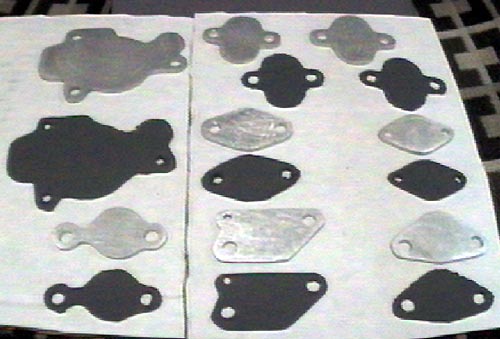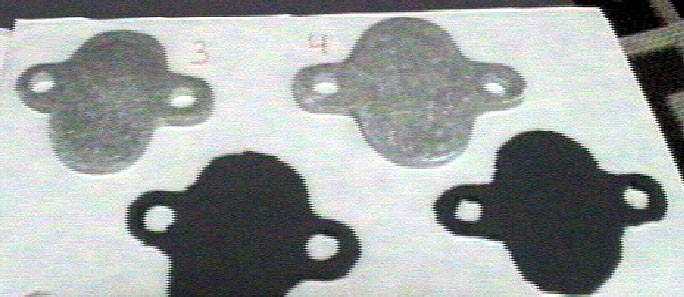Non-Sequential Simplification
Date: Sun, 30 May 1999 20:02:03 -0400
From: Sandy Linthicum (sandy_linthicum@mindspring.com)
You can convert to non-seq without taking the turbo off by
simply disconnecting 95% of the control system and wiring the
precontrol stuff fully open or closed (ie. deactivate everything
but primary wastegate.
This gives you 95% of the non-seq total mod but still let you go
back to seq with no sweat. Lets you get a feel for how it works
and responds and if you do not like it you can go back to
stock. main advantange for most of us of non-seq is simple
operation and reliability - plus drasticly reduced cracking of
the exhaust side turbo houseing due to constant heat cycling of
of seq control. Turbo control becomes 1000% simpler to
troubleshoot to the level that even I, after lots of study etc
can do it myself. There are only a few shop in the us that
really understand the seq system and can keep it working right.
If you do not live near one of them then you have some tough
choices to make.
If your seq system is working OK now, leave it alone till you
have trouble.
Disadvantage is you need to dump the CATs to make it work well
(you need the higher flow to reduce lag plus an open intake), its
makes the car louder and instant 10-12 psi boost at 3000rpm is
history - boost build slower (not really lag) and its about 4000
or more when its full bore. For no-brainer street performance
the seq is hands down better.
I ran 2.5 yrs with the kluged up non-seq with no problems. When
you permanately mod it to nonseq by physically removing and
machineing/welding out the seq stuff you improve turbo eff so
much that just about everyone who does this has boost control
problems (ie. at 6000rpm and up you cannot keep boost under 14psi
because you have exceeded what the wastegate with all reasonable
mods & enlargements can handle.
_______________
David Liberman (david@rx-7.net)
And, if you run non-sequential, use the charge relief valve as a second
blowoff valve. Just T it into the line to the primary valve, and it will
vent the secondary turbo better than the ABV will.
________________
Date: Sat, 29 May 1999 13:17:12 -0700
From: "Brian L. Goble" (goble@lith.com)
I am in the process of converting to non-sequential with the help of Jim,
Justin, and Trev. I slapped up a quick
page
with 10 pictures. This is part
1, where everything necessary is off the car (and on my garage floor). I
hope these pictures are interesting to some of you who maybe haven't seen
the turbos and exhaust manifold before.
________________
Date: Thu, 13 Jan 2000 11:14:20 -0800 (PST)
From: Mark Valskis (mvalskis@yahoo.com)
Subject: Re:(rx7)[3]sequential simplification? (emissions elimination)
> I have reason to believe the sequential control system can be
> simplified, but still function the same as far as boost pattern.
> Do any of the control system experts on this list know of a way to
> remove hoses and solenoids that aren't absolutely necessary for the
> operation of the sequential system?
Sequential simplification isn't really a valid title,
since you are not talking about affecting any of the
sequential control hardware.
That said, at least half
of the solenoids and a lot of the rat's nest is due to
emissions controls. If you don't have to deal with
emissions at all, you could get rid of these things
and reduce the bundle and clutter substantially. If
you are still running the factory ECU, you would have
to wire in resistors to the wires that used to connect
to the solenoids so that the ECU didn't trigger an
error code. The list of solenoids which control the
emissions are as follows:
Purge Control Solenoid
Relief1 Solenoid
Relief2 Solenoid
Port Air Bypass Solenoid
Split Air Bypass Solenoid
Switching Solenoid
Additionally, you could disable the accelerated warmup
system and eliminate the AWS Solenoid.
You would be left with:
Idle Speed Control Solenoid
Pressure Regulator Control Solenoid
Turbo Pre-Control Solenoid
Turbo Control Solenoid
Charge Relief Solenoid
Charge Control Solenoid
Wastegate Control Solenoid
_______________
From: Wade Lanham (walanham@mountaineergas.com)
Date: May 10, 2000
See the following diagram:

The parts are in their approximate position on my car.
See the following photos:


I made this change because I wanted to keep the sequential system
for now, but I wanted the car to be easier to work on and look cleaner under
the hood. I envy the non-sequential look. :)
"Thanks" to Mark Valskis and Derek Vanditmars for answering
questions, and Mike Putnam for putting together the "turbo control systems
ONLY" colored diagram.
The ways I succeeded:
- The system is very simple now - there are few enough hoses and
solenoids that I know where they should connecte and what they do.
- The engine looks marginally cleaner fully assembled, and much
cleaner with the upper manifold removed (where the lack of solenoids/hoses
really shows).
- Almost every hose is easy to see and reach without removing ANY
parts. I placed the solenoids and most hoses just behind the alternator but
in front of the upper manifold. If a hose does pop off, it shouldn't be
hard to fix.
- I have a box that weights about 15 lbs that has nothing but
stock "junk" hoses, tubes, valves, etc.
The ways I failed:
- The engine looks only marginally cleaner when fully assembled.
- There are still approximately 25 vacuum hoses.
- My car runs poorly when cold (I think this is because of the
fast idle cam removal - I'll know for certain soon).
Notes:
- In the diagram, I show nothing for the fuel pressure regulator. I did
some fuel system work at the same time as the vacuum system which included
an aftermarket fuel pressure regulator that I attached to the nipple on the
bottom of the lower intake manifold (same source location as stock but with
only one hose.) You MUST leave the stock system intact OR add an
aftermarket pressure regulator of some kind. For those not modifying their
fuel system at this time, be SURE to have the FPR solenoid and lines
attached well and correctly (failure of any of these parts could easily
cause engine failure).
- I left the colors the same as Mike Putnam's (?) colored flow diagram and
system diagram. His diagrams were essential for me to make these changes to
my system successfully. I recommend printing both of his diagrams and mine
if you plan to perform this modification.
- For the Charge Control Solenoid and Charge Relief Solenoid lines that T,
and the oil metering vacuum line T, I used some plastic Ts from the local
auto parts store. For the Vacuum Chamber connections I used 5-way that has
a nipple on each end and three nipples coming off the side. I removed all
other metal tubes and Ts except for the tubes running down to the intake
elbow and the turbo actuators (it is left in the diagram) because it seemed
like removing these would make the area cluttered with silicon hose instead.
- I removed all the metal hoses for fuel/coolant. All the coolant lines
were replaced with one that runs from the back of the block to the filler
neck in a straight shot. All the fuel lines were removed because I tapped
the injector rails and used braided stainless. Most people will probably be
leaving all of these fuel and coolant lines stock.
- I removed all of the solenoid "Rack." The rack was replaced with a
small piece of aluminum that now holds the CC, CR, and the TC actuator (that
is normally on the ACV). The new AL rack is attached to the upper tab on
the coil box. There are two of these - I think they might have been
attached to the original rack (?). The Pressure chamber is mounted upside
down where the ACV used to be. You could put it wherever you want. The
other TC black solenoid rack valve is located in between the new rack and
the lower intake manifold in approximately the same position as in the
diagram.
- I removed the ACV, EGR, DT, AWS, and Fast Idle cam. I probably should
have left the fast idle cam, because my car now runs like crap when it is
cold. These parts were replaced with blockoff plates and any solenoids that
would cause error codes were replaced with the appropriate resistors
attached to connectors that would slide into the original harness (I didn't
really want to cut the stock harness up at this point).
You can get the resistance of the solenoids from the
workshop manual. If anything, go a little on the high side.
- I left the uncolored hose (in my diagram) on my car. I meant to remove
it, but forgot until it was inconvenient.
- I left the fuel evaporative system intact at this time, sans some of the
unnecessary plumbling.
- I rewrapped a lot of the main harness because the shrink wrap shattered
when I moved the harness around.
- I removed the nipple for the PVC from the manifold (capped the filler
neck nipple), and the double throttle plates and related hardware. I tapped
both manifold holes and plugged them.
- The orange line that seems to go to nowhere goes to the upper intake
manifold (it should be obvious, just thought I'd mention it before someone
asked).
- I used one of the nipples on the back of the intake manifold for my
boost gauge.
I think that's it for now. As I think of more, I'll make
adjustments to the diagram and this document. If you have any suggestions
or question, just leave me a message. I'm not very busy this week at work
(if you couldn't tell already from the length of this message).

Non-Sequential Kit
Date: Thu, 14 May 1998 18:54:09 -0700
From: Trey Cobb (trey@rx-7.com)
Hello all! Sorry about bringing up a "commercial" subject on the list but
you guys/girls always give good input so here it goes.
We're thinking about offering a Non-Sequential Conversion kit that would
include a modified, ported manifold, possibly ceramic coated, with all the
instructions and additional pieces needed to convert the car from
Sequential to Non-Sequential operation. We'd offer the kit on an exchange
basis for your old manifold.
Cost would be approximately $300-$400 and would be great for someone that
wants to perform the conversion over the weekend instead of having the car
down for awhile getting the parts modified.
We're aware of the controversy about Non-Sequential vs Sequential but for
those that are looking to do the conversion, this might be a simple method
of doing it.
Please email me directly with any comments and/or suggestions. Thanks!
Trey Cobb trey@rx-7.com
Rotary Performance - Online! http://www.rx-7.com
Garland, TX 972-530-3335
_______________
Date: Fri, 15 May 98 06:59:50 -0500
From: "Linthicum, Sandy" (linthias@sandy-ntws.usps.gov)
My personal opinion, way too high. Not only expensive but you are skipping
the important part needed on the turbo -
making the wastegate bigger, welding and/or grinding out the
restriction/controls that are not used with nonsequential but without moding
the turbo both get in the way and cause restriction and/or can still fail
and cause a problem.
Much more reasonable to ship your turbo & manifold to Pettit overnight, have
him mod & blueprint/rebuild and get it back overnight.

![[ Mail me ]](mail.gif)
![[ To Lightning home page ]](rx7_home.gif)
![[ To my home page ]](my_home.gif)
![[ Copyright Notice ]](copyright.gif)












